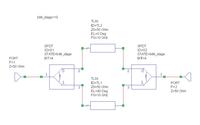Shoma Chandorkar
Junior Member level 2
phase shifter design
I wanna design 6 bit phase shifter with lumped elements (L & C) using Microwave Office . It can be designed using hign pass and low pass circuit and a pair of SPDT switch. But how this switching will take place?
I wanna design 6 bit phase shifter with lumped elements (L & C) using Microwave Office . It can be designed using hign pass and low pass circuit and a pair of SPDT switch. But how this switching will take place?
